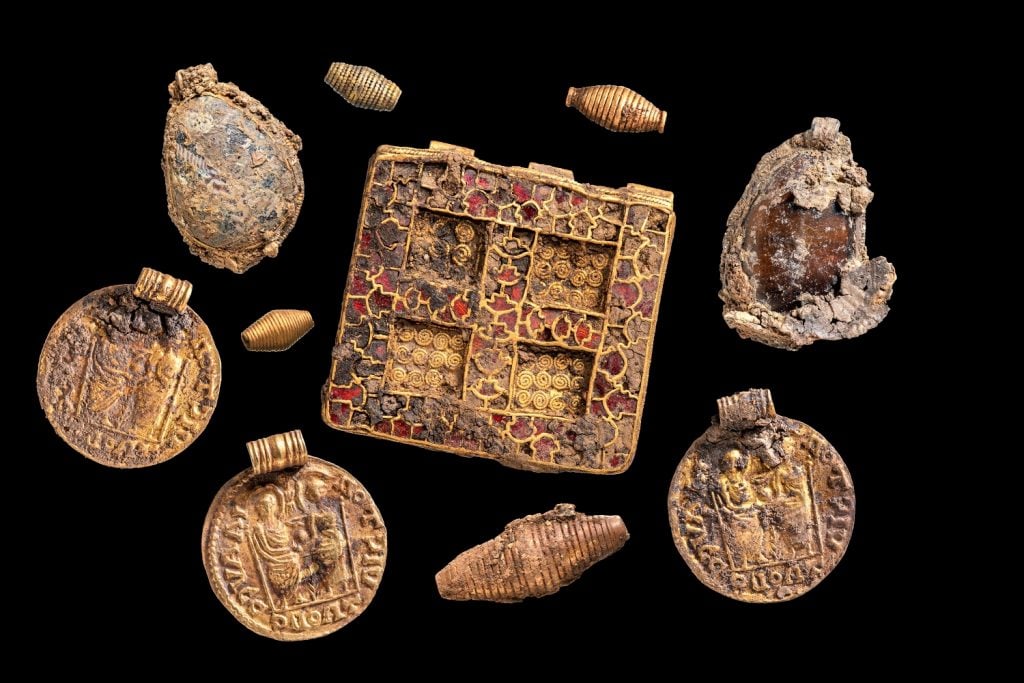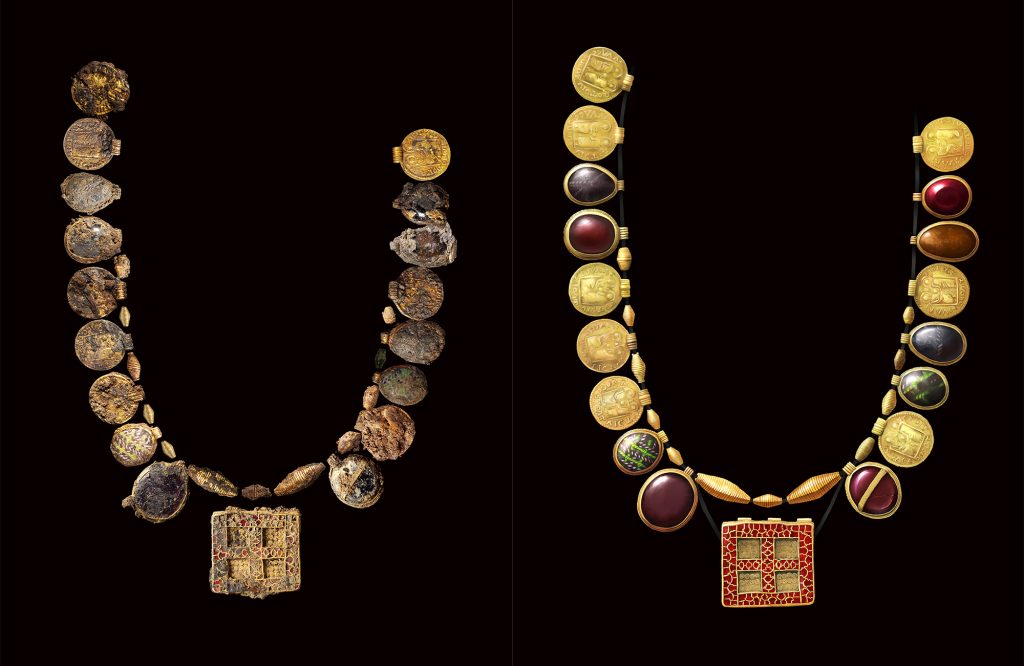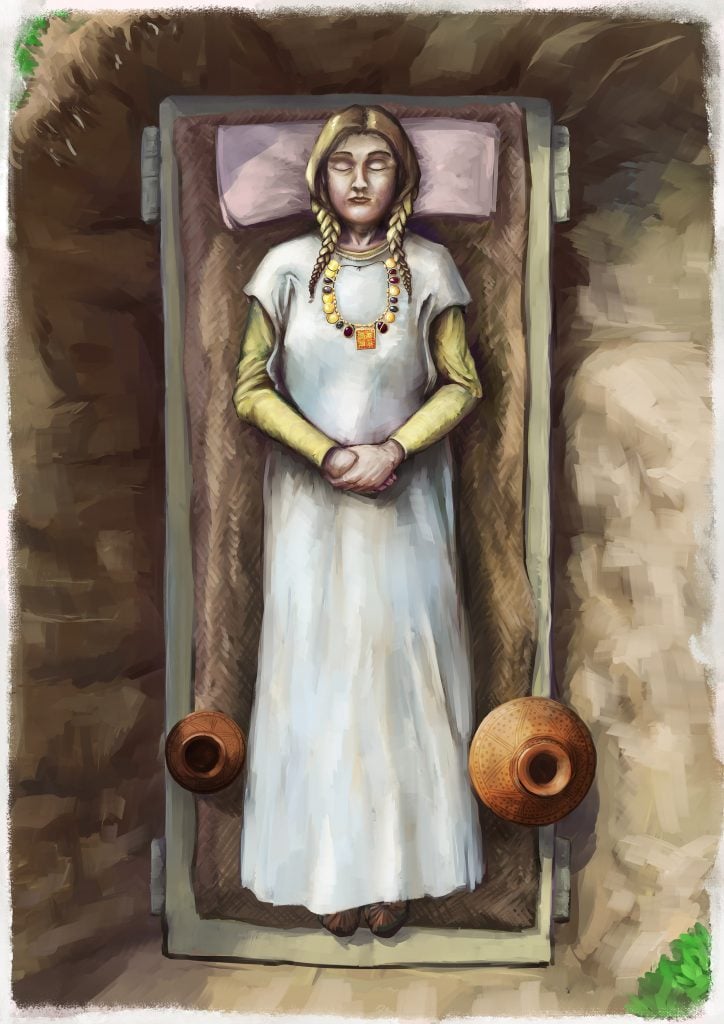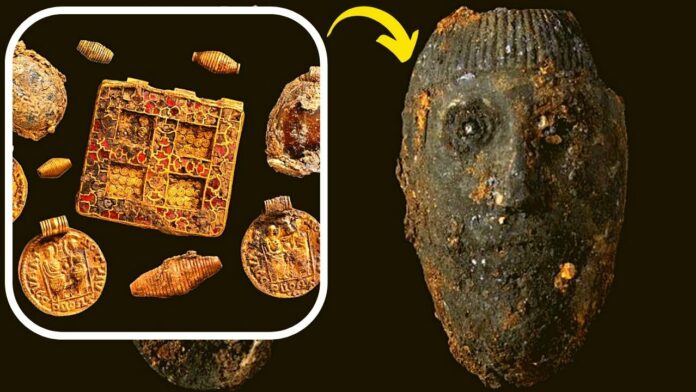In the rolling hills of Northamptonshire, England, a remarkable discovery has been made that is set to reshape our understanding of the early medieval period. An exquisite gold necklace, adorned with 30 pendants and beads crafted from gold Roman coins and semi-precious stones, has been unearthed at the burial site of a powerful woman who was laid to rest over 13 centuries ago. This once-in-a-lifetime find, known as the “Harpole Treasure,” is a testament to the rich cultural and religious tapestry that characterized the region during a time of immense transition.
The Harpole Treasure: A Glimpse into the Past

The necklace, discovered in the village of Harpole, is a striking example of the artistry and craftsmanship that flourished in seventh-century England. The large rectangular pendant features a cross, suggesting that the deceased may have been an early Christian religious leader. The use of precious metals and stones further indicates her high status and wealth, hinting at the growing influence of women within the new faith.
Accompanying the exquisite necklace was an equally remarkable artifact – an ornate silver cross, which scholars believe would have been laid upon the woman’s chest during her burial. These finds, along with the clay pots from France or Belgium that were found alongside her, paint a vivid picture of the cultural and religious landscape of the time.
The Significance of the Discovery

The discovery of the Harpole Treasure is a profound moment in the study of early medieval England. As Lyn Blackmore, a specialist at the Museum of London Archaeology (MOLA), aptly noted, “She was extremely devout, but was she a princess? Was she a nun? Was she more than a nun—an abbess? We don’t know.” This mystery surrounding the identity of the woman adds to the excitement and intrigue surrounding the find.
Moreover, the wealth and status associated with this burial challenge the traditional narratives of the early medieval period. Previously, such lavish burials had been reserved for men, suggesting that by the seventh century, women were gaining significant influence and recognition within the emerging Christian faith.
“The scale of the wealth is going to change our view of the early medieval period in that area,” said Simon Mortimer, of Archaeological Consultants, RPS, who supported the excavations. “The course of history has been nudged, ever so slightly, by this find.”
The Preservation and Dissemination of the Harpole Treasure

The Harpole Treasure is now in the hands of the MOLA conservators, who are meticulously analyzing the artifacts to uncover their secrets. From evidence of how the objects were used in life or during burial rites to the potential identities of the woman, these examinations promise to shed further light on this remarkable discovery.
Importantly, the developer of the land, Vistry Group, has generously waived any rights to the Harpole Treasure, ensuring that it will be gifted to the nation and put on display in a local museum. This commitment to preserving and sharing this cultural heritage is a testament to the importance of collaboration between developers, archaeologists, and the public.
Furthermore, the Harpole Treasure will be featured on the new series of BBC Two’s “Digging for Britain,” scheduled to air in early January 2023. This national platform will bring this extraordinary find to the attention of a wider audience, sparking greater interest and appreciation for the rich history of early medieval England.
Conclusion
The discovery of the Harpole Treasure is a testament to the enduring power of archaeology to uncover the hidden stories of the past. This exquisite gold necklace, adorned with Roman coins and semi-precious stones, is a tangible link to a time of great cultural and religious transformation in England. The identity of the woman buried with this treasure may forever remain a mystery, but her legacy lives on, challenging our understanding of the early medieval period and inspiring us to delve deeper into the fascinating history of this remarkable region.
